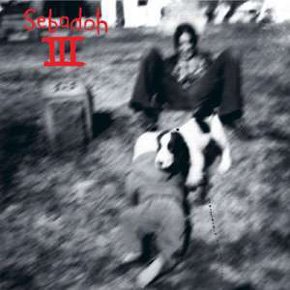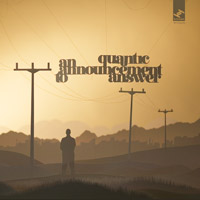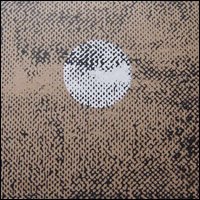Barlow's Wry, Introspective Folk & Gaffney's Psychedelic Noise Rock Experiments...Who Could It Be?
 Originally Lou Barlow's bedroom side project while he was playing bass in Dinosaur Jr., Sebadoh went from soft 4-track sad boy ruminations to full on rambunctious indie rock without losing Barlow's tender hearted, mopey moodiness. This record, III, is where they really clicked. To be totally honest, the first two are our absolute favorites (c'mon, somebody reissue The Freed Weed!!!) but until those are available again, we'll just have to cast our lot with III. Not entirely fair to compare them though. The first two Sebadoh records were just Lou, in his bedroom, singing and strumming, a ramshackle collection of sweet sad songs and freaked out tape experiments, where as by the time of III, Sebadoh was a real rock band, with not just two other band members, but two other songwriters, Eric Gaffney and Jason Lowenstein. Giving Sebadoh a distinctly schizophrenic sound, veering from introspective to noisy and annoying depending on whose song it was.
Originally Lou Barlow's bedroom side project while he was playing bass in Dinosaur Jr., Sebadoh went from soft 4-track sad boy ruminations to full on rambunctious indie rock without losing Barlow's tender hearted, mopey moodiness. This record, III, is where they really clicked. To be totally honest, the first two are our absolute favorites (c'mon, somebody reissue The Freed Weed!!!) but until those are available again, we'll just have to cast our lot with III. Not entirely fair to compare them though. The first two Sebadoh records were just Lou, in his bedroom, singing and strumming, a ramshackle collection of sweet sad songs and freaked out tape experiments, where as by the time of III, Sebadoh was a real rock band, with not just two other band members, but two other songwriters, Eric Gaffney and Jason Lowenstein. Giving Sebadoh a distinctly schizophrenic sound, veering from introspective to noisy and annoying depending on whose song it was."Sickles And Hammers"
Years before Conor Oberst ascended to the weepy, slouchy indie throne, Sebadoh's Lou Barlow was already the king of the lo-fi tearjerker. He ruled the roost of unabashed romantics in his rumpled threadbare cardigan, spectacles and tousled mop of hair. However, as III proved beyond a doubt, Sebadoh wasn't confined to lovey-dovey bedroom balladry, nope they could tear shit up a-plenty providing both cathartic heartbaring sadsack sweetness and blistering noise rawk for indie kids near and far.
The copious liner notes are a bit confusing though. As far as we were concerned, Sebadoh WAS Lou Barlow, who was later joined by Eric and Jason. But the liner notes, especially Gaffney's, paint a quite different picture.
"Gimme Indie Rock"
Gaffney goes on and on about how it was basically his band and his songs. But a quick listen to the record (and a look at each member's subsequent sonic track record) reveals the truth, that Lou was still the quiet mastermind. Eric has some killer tracks for sure, and Jason's songs are wild and chaotic (this was before he would grow into a songwriter to rival Lou on later Sebadoh discs) but almost without exception the perfect pop gems here are penned by Lou. Just check out the opener "The Freed Pig", hard to imagine a more perfect indie rock song. Jangly and catchy, a little ramshackle, a teensy bit melancholy, but exuberant and hopeful. With a killer crunchy chorus.
III is peppered with sweet soft acoustic numbers that sound like they were plucked from old Sebadoh cassettes. Each one sad and lovely, perfect mix tape material way back in 1991 (Yeesh, has it really been fifteen years?!), the prototype for EVERY home recorded bedroom record since. Jason contributes some Minutemen sounding instrumental jams ("Sickles & Hammers"), some slow motion druggy stoner jams ("Smoke A Bowl"), a killer twangy acoustic hoedown ("Black Haired Girl") and most of the really esoteric tunes. Eric offers up some lilting minor key jangle ("Violet Execution"), some super fuzzed out jangly tribal psych rock ("Limb By Limb") and the super lengthy bizarre drugged out psych jam "As The World Dies The Eyes Of God Grow Bigger". Between all of these musical flights of fancy, Lou gives us perfect pop song after perfect pop song, whether it's in the form of a whispered mumbly song fragment, or a glorious rocked out jangly jam. Somehow these disparate elements mesh perfectly into a totally rollicking chaotic indie rock masterpiece. A reissue of III on its own would definitely merit record of the week status, but there's a whole extra disc of singles and outtakes that make this absolutely essential.
"Scars, Four Eyes"
 First up on the extras disc is "Gimme Indie Rock" a tongue in cheek slam on their more popular indie contemporaries, which inadvertently became a hit and somehow sounded like, but better than, all the bands it was poking fun at (check out the very Dinosaur-like leads!) Speaks volumes that a tossed off fuck around track can be this good. Next up is quite possibly the best Sebadoh song ever "Ride The Darker Wave" a loping groove, with a totally catchy guitar part and an instantly unforgettable melody. Heavy and sludgy but perfectly poppy. The rest of the disc is jam packed with outtakes and alternate versions, a whole bunch of Gaffney tracks, as good as anything on the record proper, as well as a few other Lou gems. Also, tacked on at the very end is "Showtape '91" a 12 minute experimental tape piece, the band used to play at shows before they came on stage. It features the band reading various reviews (positive and negative), repeating the various mispronunciations of the band name, all amidst a cacophonous soundscape of tape manipulation and guitar grind. Very annoying but very very funny.
First up on the extras disc is "Gimme Indie Rock" a tongue in cheek slam on their more popular indie contemporaries, which inadvertently became a hit and somehow sounded like, but better than, all the bands it was poking fun at (check out the very Dinosaur-like leads!) Speaks volumes that a tossed off fuck around track can be this good. Next up is quite possibly the best Sebadoh song ever "Ride The Darker Wave" a loping groove, with a totally catchy guitar part and an instantly unforgettable melody. Heavy and sludgy but perfectly poppy. The rest of the disc is jam packed with outtakes and alternate versions, a whole bunch of Gaffney tracks, as good as anything on the record proper, as well as a few other Lou gems. Also, tacked on at the very end is "Showtape '91" a 12 minute experimental tape piece, the band used to play at shows before they came on stage. It features the band reading various reviews (positive and negative), repeating the various mispronunciations of the band name, all amidst a cacophonous soundscape of tape manipulation and guitar grind. Very annoying but very very funny."Ride The Darker Wave"
As befits a classic record like III, the packaging and reissue extras are amazing. Besides the wealth of extra and unreleased tracks, there are extensive liner notes from all three band members, tons of photos, and the whole thing is housed in a snazzy slipcase with the band name and album title embossed in metallic gold ink. We feel like we're 21 again!!! Amazing Reissue.
Text By Aquarius Records
Sebadoh Page








